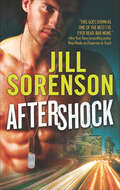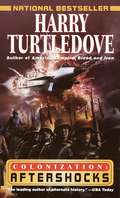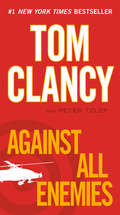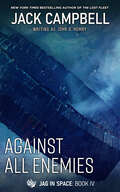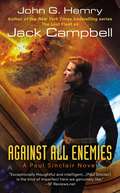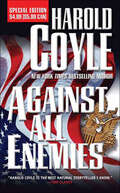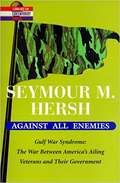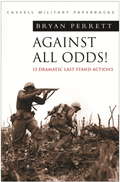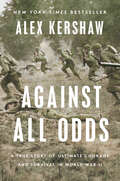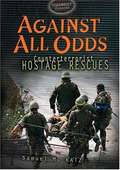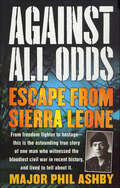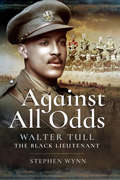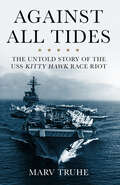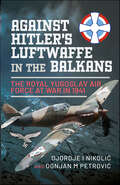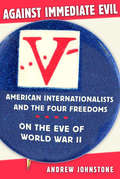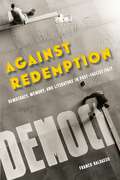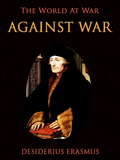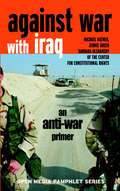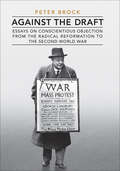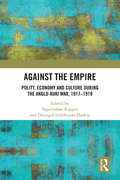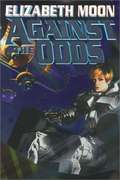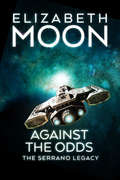- Table View
- List View
Aftershock (The Aftershock Novels #1)
by Jill SorensonA “fast paced romantic thriller” about two earthquake survivors who team up and fall in love is a “twisty roller-coaster ride [that] keeps pages turning” (Publishers Weekly, starred review).As an emergency paramedic, Lauren Boyer is dedicated and highly capable. Until an earthquake strikes, trapping her beneath the freeway with a group of strangers—including Iraq war veteran Garrett Wright.Handsome and take-charge Garrett aids Lauren in her rescue efforts, even as the steely look in his eyes seems to hide dark secrets. When a gang of escaped convicts goes on the attack, Garrett’s bravery makes him more than a courageous bystander to Lauren. If they can save the others before time runs out, maybe, just maybe, they can explore the fire igniting between them—if the truth about who he really is doesn’t pull them apart forever. . . . “As the survivors fight for their lives, Sorenson describes everything in stunning detail to create a riveting romantic adventure.” —Booklist
Aftershocks (Colonization #3)
by Harry Turtledove"ONE OF THE MOST MEMORABLE SERIES OF ALTERNATIVE HISTORY NOVELS EVER WRITTEN."-Science Fiction Age World War II has evolved into decades of epic struggles and rebellions targeting the aliens known as the Race. As the 1960s begin, one of Earth's great powers launches a nuclear strike against the Race's colonization fleet-and the merciless invaders find themselves confronting a far more complex and challenging species than any they have encountered before. Ultimately, only superior firepower may keep Earth under the Empire's control-or it may destroy the world. While uprisings and aftershocks of war shake the planet, one nation plots a stunning counterattack . . ."Hugo winner Turtledove lives up to his billing as the grand master of alternative history. . . . This novel is altogether excellent."-Publishers Weekly (starred review)From the Paperback edition.
Against All Enemies (A Campus Novel #1)
by Tom Clancy Peter TelepThe master of international intrigue and explosive action introduces a new hero for a new era of warfare . . . against a new kind of threat. Get ready to meet ex-Navy SEAL Max Moore. For years, ex-Navy SEAL Max Moore has worked across the Middle East and behind the scenes for the Special Activities Division of the CIA, making connections, extracting valuable intelligence, and facing off against America's enemies at every turn. When Moore arrives at a rendezvous to take charge of a high-ranking Taliban captive, the meeting takes a horrific turn that neither Moore nor any of his bosses saw coming. Barely surviving, he tries to bring to safety a Pakistani colonel with information about the debacle, only to have that mission fall prey to forces more powerful and cunning than any he has faced before. Undaunted, and with failure not an option, Moore continues his quest for the truth, leaving many dead in his wake--killed by those for whom secrecy is the ultimate weapon. In a story that races from the remote, war-scarred landscapes of the Middle East to the blood-soaked chaos of the U. S. -Mexico border, Tom Clancy once again delivers a heart-stopping thriller that is frighteningly close to reality.
Against All Enemies (JAG in Space #4)
by Jack CampbellNew York Times bestselling author John G. Hemry’s concludes his dramatic sci-fi JAG in Space series with a mission that will push a young officer to the edge. After surviving several harrowing adventures on his extended tour as Legal Officer aboard the USS Michaelson—newly promoted full Lieutenant Paul Sinclair is looking forward to some sorely deserved shore leave. Unfortunately, as has happened so many times before, duty intervenes.A violent group of religious fanatics has hijacked an asteroid that could cause an extinction-level event on Earth. Soon, the largest armada in history with starships from several world powers in uneasy cooperation converges on the killer rock. Then, the tension explodes when the South Asian Alliance opens fire, leading to an all-out massacre—and raising Sinclair’s well-honed suspicions.During the engagement, the Alliance acted as if they had the Michaelson’s rules of engagement. But how? Sinclair’s instincts are proven right when he’s tasked to go undercover for NCIS and find a traitor. Now, with no law or court to back him, Sinclair is the only one who can see justice done.“Hemry’s real-world experience gives the investigation and subsequent courtroom scenes a convincing feel. If you crave a legalistic space-Hornblower, you’ll enjoy this one.” —Analog“Hemry concludes an exceptionally thoughtful and intelligent series on a strong note.” —SF Reviews
Against All Enemies (JAG in Space, Book #4)
by John G. HemryAfter a long tour as legal officer aboard the starship USS Michaelson, Paul Sinclair is anticipating shore duty. Unfortunately, it's canceled when a group of religious fanatics hijacks a freighter and invades an asteroid. Fearing they could threaten the Earth with asteroid debris, several countries send their own ships to the scene. But their mission turns deadly when the South Asian Alliance opens fire on the asteroid. When the smoke finally clears, Paul suspects the Michaelson's rules of engagement have been compromised--a suspicion that is confirmed when NCIS asks him to work covertly as a spy. Someone onboard the Michaelson is selling secrets, and to uncover the traitor, Paul must walk the dangerous line between duty and honor...
Against All Enemies (Nathan Dixon #2)
by Harold CoyleThe bestselling author of Team Yankee, "master of military fiction" Harold Coyle returns. In a novel both exciting and frighteningly realistic, Harold Coyle demonstrates once again that one of the nation's most important struggles is being fought on its own territory.Freedom. It is brought settlers to America's coasts, and it's the ideal that many laid down their lives to preserve. But, as the greatest nation in the world enters the new millennium, America finds itself once again split over the concept of liberty and justice for all.When one man decides to send a message to the government by bombing a federal building, the explosion is felt all across the country. The chain reaction that follows resonates most powerfully with members of a rebel band in Idaho who call themselves "Patriots" they want freedom from government control, no matter how much deadly force it takes. Their well-planned acts of terrorism soon show the government that they cannot be ignored and that definite action is needed.Thrown into the battle is Lieutenant Nathan Dixon, fresh from VMI, and a soldier who stands in the very large shadow of his father, the revered General Scott Dixon. Sent to quell a potentially dangerous situation, he'll need every bit of his training, for Nathan finds himself catapulted into the first battle of a new American war of secession.Covering the news is Nathan's stepmother, prominent anchorwoman Jan Fields. As the country watches, Jan discovers that Idaho's charismatic governor, George Oliver "GO" Thomas has an agenda of his own, one that may truly have a revolutionary effect on the whole country.Using the hard-edged style that made him famous, Harold Coyle takes us inside an all too plausible America where a nation is divided over the ideals on which this country was founded. In this modern military thriller, Coyle gives us an intimate portrait of the men and women who fight to uphold their, visions of America against all enemies. At the Publisher's request, this title is being sold without Digital Rights Management Software (DRM) applied.
Against All Enemies: The Gulf War Syndrome, The War Between America's Ailing Veterans and their Government
by Seymour M. HershThe dangers, hidden from combatants by the Government, resulted in suffering and uncompensated damages.
Against All Odds! (W&N Military)
by Bryan PerrettThe story of dramatic military actions where a few fought against many, often with unbelievable success.From the Napoleonic Wars to Korea, Bryan Perrett has found a further 13 dramatic military actions where a few fought against many, often with unbelievable success. The events take place in Europe, Africa, Asia and North America; they are linked only by the bravery and devilment which led military men to risk their lives for a last ditch attempt to advance their cause. Attending to the important facts and statistics required by the military historian, the author avoids invention and undue surmise whilst also avoiding the dry lecturing style found in so many volumes describing military strategy. The result is an absorbing, exciting and above all accurate account of astonishing battlefield warfare: narrative history of the sort at which Bryan Perrett excels.
Against All Odds!: More Dramatic `last Stand' Actions (Sven Hassel War Classics)
by Bryan PerrettThe story of dramatic military actions where a few fought against many, often with unbelievable success.From the Napoleonic Wars to Korea, Bryan Perrett has found a further 13 dramatic military actions where a few fought against many, often with unbelievable success. The events take place in Europe, Africa, Asia and North America; they are linked only by the bravery and devilment which led military men to risk their lives for a last ditch attempt to advance their cause. Attending to the important facts and statistics required by the military historian, the author avoids invention and undue surmise whilst also avoiding the dry lecturing style found in so many volumes describing military strategy. The result is an absorbing, exciting and above all accurate account of astonishing battlefield warfare: narrative history of the sort at which Bryan Perrett excels.
Against All Odds: A True Story of Ultimate Courage and Survival in World War II
by Alex Kershaw*The instant New York Times bestseller*The untold story of four of the most decorated soldiers of World War II—all Medal of Honor recipients—from the beaches of French Morocco to Hitler&’s own mountaintop fortress, by the national bestselling author of The First Wave &“Pitch-perfect.&”—The Wall Street Journal • &“Riveting.&”—World War II magazine • &“Alex Kershaw is the master of putting the reader in the heat of the action.&”—Martin Dugard As the Allies raced to defeat Hitler, four men, all in the same unit, earned medal after medal for battlefield heroism. Maurice &“Footsie&” Britt, a former professional football player, became the very first American to receive every award for valor in a single war. Michael Daly was a West Point dropout who risked his neck over and over to keep his men alive. Keith Ware would one day become the first and only draftee in history to attain the rank of general before serving in Vietnam. In WWII, Ware owed his life to the finest soldier he ever commanded, a baby-faced Texan named Audie Murphy. In the campaign to liberate Europe, each would gain the ultimate accolade, the Congressional Medal of Honor. Tapping into personal interviews and a wealth of primary source material, Alex Kershaw has delivered his most gripping account yet of American courage, spanning more than six hundred days of increasingly merciless combat, from the deserts of North Africa to the dark heart of Nazi Germany. Once the guns fell silent, these four exceptional warriors would discover just how heavy the Medal of Honor could be—and how great the expectations associated with it. Having survived against all odds, who among them would finally find peace?
Against All Odds: Counterterrorist Hostage Rescues
by Samuel M. KatzLooks at ten high-profile hostage rescues, explaining the history and politics behind such cases as the hijacking of a school bus carrying thirty students in East Africa and the seige of a Moscow theater in 2002.
Against All Odds: Escape from Sierra Leone
by Phil AshbyAgainst All Odds is the incredible true story of that escape-and of the heart-pounding courage of Major Phil Ashby who defeated the rebel forces of Sierra Leone and became a living testament to the power of the human spirit and the sheer determination to survive. In West Africa's war-ravaged Sierra Leone no one was getting out alive. It took the courage of one man to change the odds.By 1990, Sierra Leone, once hailed as the 'Athens of West Africa', had degenerated into a savage battlefield, overtaken by rebel forces in a devastating civil war. Assigned to spearhead the mission as UN peacekeeper was Major Phil Ashby. But by 2000, the rebel occupation he had worked so diligently to disarm rose again to control an astounding two-thirds of the country. The enemy's mission: get rid of the outside opposition first. A number of Ashby's colleagues were tortured and finally butchered, and more than 500 were taken as hostages. Among the hostages was Phil Ashby. Miles from civilization, with no rescue in sight, Ashby and three of his men knew that their fate was up to them alone. Lost deep inside the rebels' heartland, unarmed, and outnumbered 20-to-1, Ashby devised a plan to escape from the hostile jungles that would test fate and challenge all reason.
Against All Odds: Walter Tull the Black Lieutenant
by Stephen WynnWalter Tull would have been a remarkable individual no matter when he had been born, but to achieve what he did, during the time that he did, makes him even more remarkable. He was an orphan at just six years of age, and despite not wanting to, his step mother, Clara, had no choice but to place him and his elder brother, Edward, in to a children's home in the East End of London. As neither Walter or Edward had ever traveled outside of Folkestone before, the upheaval must have come as quite a shock. Two years after entering the home, Walter and Edward were split up when Edward was adopted and went to live in Glasgow.Walter's sporting prowess saw him play for top local amateur side, Clapton Football club, signing for them in 1908, but it was to be a short lived affair, as by the following year he had signed as a professional for the prestigious Tottenham Hotspur Football Club, making his first team debut against Manchester United.In October 1911 Walter was transferred to Northampton Town Football Club, where he would go on to play over one hundred first team games, before the First World War brought a premature end to his career as a professional footballer. With the outbreak of war, Walter wasted no time enlisting in the British Army, initially as a Private in the newly formed 17th (Football) Battalion, Middlesex Regiment. Further promotions followed and in no time at all he had reached the rank of Sergeant.He was put forward for a commission and passed out as a 2nd Lieutenant on 29 May 1917. He went on to become the first black officer in the British Army, to lead white troops in to battle, and was fondly regarded by the men who served under him.Walter was killed in action whilst leading his men in a counter attack against German defensive positions on Monday 25 March 1918. He died a hero. He was well liked and respected by all who knew him. Like many men of his generation his life was cut short for the greater good whilst in the service of his country, so that others might prevail.
Against All Tides: The Untold Story of the USS Kitty Hawk Race Riot
by Marv TruheSimmering racial tensions inflamed by discriminatory punitive measures sparked a violent confrontation aboard the USS Kitty Hawk while it was engaged in air strikes off the coast of North Vietnam. The US Navy charged Black sailors with rioting and assaults on White sailors in an incident referred to as a race riot, while totally ignoring violent unprovoked assaults committed by White sailors and Marines. Author Marv Truhe was a Navy JAG defense lawyer seeking justice for the accused Black sailors. Truhe possesses one of the most complete collections, personal or institutional, of original source documents of the Kitty Hawk incident and its legal aftermath—trial transcripts, investigation reports, hundreds of sworn statements and medical reports, federal court pleadings, and case files and witness interviews. How could virtually all official and unofficial accounts of the incident have placed blame for the incident solely on twenty-three Black sailors? How could they have been subjected to blatant racial injustices without their story being told until now? It is time to reveal the uncomfortable answers to these questions and expose the injustices perpetrated against these twenty-three young men.
Against Destiny
by Alexander DolininA fictional account of an escape from a Stalinist labor camp, showing the harsh and inhuman conditions of the Gulag and the heroism of the five unjustly condemned prisoners as they cross Siberia in a bid to reach America.
Against Hitler's Luftwaffe in the Balkans: The Royal Yugoslav Air Force at War in 1941
by Djordje I. Nikolic Ognjan M. Petrovic“The extraordinary photographs of aircraft, personnel, and facilities set this book apart.” -The Journal of the Air Force Historical Foundation Immediately following the end of the First World War, the air force of the newly-formed Southern Slav State, the Kingdom of Serbs, Croats and Slovenes, was forced to rely mainly on war-time Serbian Air Service aircraft and material left after the withdrawal of the French Armée de l’Air from the Balkans in 1919/1920. This equipment was supported by the addition of French war surplus stocks which started arriving in 1921. In 1929 the monarchy changed its name to the Kingdom of Yugoslavia. Then, from 1930, the official name of the air service branch its military was changed to what is commonly known in the West as the Royal Yugoslav Air Force (RYAF). The obsolete First World War aircraft were replaced from 1925 onwards by stop-gap solutions purchased mainly from France, some from the Czechoslovakian Republic as well as from the first domestic factories. From 1936, the RYAF again began to reorganize and modernize, with the purchase of the most modern aircraft available at that time. These aircraft were imported from the UK, Germany and Italy, some being built under license in domestic factories. During this period the Kingdom of Yugoslavia succeeded, as much as conditions allowed, to equip its air force with the most advanced fighter and bomber types of the period. For the Kingdom of Yugoslavia, the Second World War started on 6 April 1941. The military coup d’etat of 27 March 1941 and anti-German demonstrations in Belgrade clearly aligned the kingdom with the Allies. That same day, Hitler ordered the implementation of Unternehmen 25 (Operation 25) – the attack against Kingdom of Yugoslavia. Hitler had also secured Mussolini’s support for this campaign, while Hungary, Romania and Bulgaria gave active or passive backing in exchange for territorial claims in Yugoslavia. Despite all the odds, the airmen of the RYAF fought gallantly in the defense of their homeland, with fighters taking on the German and Italian bombers and their escort fighters – including the Axis types in service with the RYAF. Eventually, due to the deteriorating situation on the front and the ever-increasing risk of the king and his government being captured, the decision was taken to evacuate by air to Greece. In the summer of the 1941 some 220 Yugoslav aviators gathered in Egypt and continued the fight against Axis, this time in the colors of the RAF. This is the full story of their service and combats in the early months of that year.
Against Immediate Evil: American Internationalists and the Four Freedoms on the Eve of World War II
by Andrew JohnstoneIn Against Immediate Evil, Andrew Johnstone tells the story of how internationalist Americans worked between 1938 and 1941 to convince the U.S. government and the American public of the need to stem the rising global tide of fascist aggression. As war approached, the internationalist movement attempted to arouse the nation in order to defeat noninterventionism at home and fascism overseas. Johnstone's examination of this movement undermines the common belief that the Japanese attack on Pearl Harbor wrenched an isolationist United States into global armed conflict and the struggle for international power. Johnstone focuses on three organizations—the American Committee for Non-Participation in Japanese Aggression, the Committee to Defend America by Aiding the Allies, and Fight For Freedom—that actively promoted a more global role for the United States based on a conception of the "four freedoms" later made famous by FDR. The desire to be free from fear was seen in concerns regarding America’s immediate national security. The desire to be free from want was expressed in anxieties over the nation’s future economic prosperity. The need for freedom of speech was represented in concerns over the potential loss of political freedoms. Finally, the need for freedom of worship was seen in the emphasis on religious freedoms and broader fears about the future of Western civilization. These groups and their supporters among the public and within the government characterized the growing global conflict as one between two distinct worlds and in doing so, set the tone of American foreign policy for decades to come.
Against Redemption: Democracy, Memory, and Literature in Post-Fascist Italy (World War II: The Global, Human, and Ethical Dimension)
by Franco BaldassoWINNER, HELEN AND HOWARD R. MARRARO PRIZE IN ITALIAN HISTORYDiscloses the richness of ideas and sheds light on the controversy that characterized the transition from fascism to democracy, examining authors, works and memories that were subsequently silenced by Cold War politics.How a shared memory of Fascism and its cultural heritage took shape is still today the most disputed question of modern Italy, crossing the boundaries between academic and public discourse. Against Redemption concentrates on the historical period in which disagreement was at its highest: the transition between the downfall of Mussolini in July 1943 and the victory of the Christian Democrats over the Left in the 1948 general elections. By dispelling the silence around the range of opinion in the years before the ideological struggle fossilized into Cold War oppositions, this book points to early postwar literary practices as the main vehicle for intellectual dissent, shedding new light on the role of cultural policies in institutionalizing collective memory. During Italy’s transition to democracy, competing narratives over the recent traumatic past emerged and crystallized, depicting the country’s break with Mussolini’s regime as a political and personal redemption from its politics of exclusion and unrestrained use of violence. Conversely, outstanding authors such as Elsa Morante, Carlo Levi, Alberto Moravia, and Curzio Malaparte, in close dialogue with remarkable but now-neglected figures, stressed the cultural continuity between the new democracy and Fascism, igniting heated debates from opposite political standpoints. Their works addressed questions such as the working through of national defeat, Italian responsibility in World War II, and the Holocaust, revealing how the social, racial, and gender biases that characterized Fascism survived after its demise and haunted the newborn democracy.
Against War (The World At War)
by Desiderius ErasmusA classic anti-war essay from the mid-1500s. Erasmus gives elegant arguments against war from both religious (Christian) and logical (economic, practical) points of view. He seems particularly alarmed and confused by Christians fighting wars with Christians. The problem, of course, is that people waging war only consider religious or logical reasons when they are looking for excuses to wage war.
Against War with Iraq: An Anti-war Primer (Open Media Series)
by Barbara Olshansky Michael Ratner Jennie GreenDespite public outcry at home and international opposition abroad, the Bush Administration deployed troops and invested millions in preparation for a massive military assault on Iraq. In this Open Media Series special edition, three legal scholars from the Center for Constitutional Rights argue persuasively that the looming war against Iraq is both unnecessary for national security, and illegal. Against War with Iraq describes the high cost of the US war in Iraq in terms of human life, as well as the economic and political havoc it will trigger. A timely and much needed anti-war primer, Against War with Iraq contains the core facts and analysis needed to understand the issues and become an effective advocate against hawkish U.S. foreign policy.
Against the Draft
by Peter BrockAround the world and for hundreds of years, men and women have refused to be drafted into bearing arms for their nations' wars. These conscientious objectors to the draft are the subject of Peter Brock's latest collection, Against the Draft. Brock, the world's leading historian on pacifism, has assembled twenty-five of his essays on conscientious objection to the draft from the beginning of the Radical Reformation in 1525 to the end of the Second World War.Included in the collection are essays on little known facets of the anti-draft movement including the Anabaptist-Mennonite tradition of military exemption that started with the outset of the Radical Reformation in 1525 and has continued, with variations, until the present. Further articles deal with the Quakers in a number of countries, Civil-war America, Leo Tolstoy (who became a convinced pacifist in the later part of his life,) British conscientious objectors in the Non-Combatant Corps, the emergence of conscientious objection in Japan, and the fate of conscientious objectors in the psychiatric clinics of Germany and in interwar Poland. Essays on the Central European Nazerenes and on Jehovah's Witnesses in Nazi Germany highlight the exceptionally harsh treatment meted out to conscientious objectors belonging to these two sects, and their steadfast resistance to the state's demand to bear arms. Against the Draft makes an important contribution to the growing study of pacifism and conscientious objection, and represents a key work in the career of the field's foremost scholar.
Against the Empire: Polity, Economy and Culture during the Anglo-Kuki War, 1917-1919
by Ngamjahao Kipgen Doungul Letkhojam HaokipThis book explores the Kuki uprising against the British Empire during the First World War in the northeast frontier of India (then the Assam–Burma frontier). It sheds light on how the three-year war (1917–1919), spanning over 6,000 square miles, is crucial to understanding present-day Northeast India. Companion to the seminal The Anglo-Kuki War, 1917–1919, the chapters in this volume: • Examine several aspects of the Anglo-Kuki War, which had far-reaching consequences for the indigenous Kuki population, including economy, politics, identity, indigenous culture and belief systems, and traditional institutions during and after the First World War itself; • Highlight finer themes such as the role of the chiefs and war councils, symbols of communication, indigenous interpretation of the war, remembrance, and other policies which continued to confront the Kuki communities; • Interrogate themes of colonial geopolitics, colonialism and the missionaries, state making, and the frontier dimensions of the First World War. Moving away from colonial ethnographies, the volume taps on a variety of sources – from civilisational discourse to indigenous readings of the war, from tour diaries to oral accounts – meshing together the primitive with the modern, the tribal and the settled. This book will be of great interest to scholars and researchers of South and Southeast Asian Studies, area studies, modern history, military and strategic studies, insurgency and counterinsurgency studies, tribal warfare, and politics.
Against the Odds
by Laura DrakeA love stronger than fear... Former army sniper Douglas "Bear" Steele wants only to be left alone to live a quiet, peaceful existence in the small town of Widow's Grove. So his attraction to Hope Sanderson is unexpected and inconvenient. Having recently survived a violent bank robbery, Hope has vowed to seize each day and leave behind her safe, ordered life. As Hope and Bear help each other heal, their desire turns to love. But with their lives moving in opposite directions, can they find a balance to let go of the past and embrace the future...together?
Against the Odds (Familias Regnant #7)
by Elizabeth MoonIMPLOSION! The worst has happened: Fleet is tearing itself apart. Some of the mutineers see injustice in the unequal spread of the rejuvenation drugs that offer virtual immortality to the rich; others are simply thirsty for power, or for blood. The Loyalists, meanwhile, fight desperately to preserve the rule of law in Familias Regnant space. But when Esmay Suiza-Serrano is unceremoniously booted out of Fleet, the apparent victim of Family politics, she has no idea of the whirlwind of conflict into which she is about to be drawn. As the noose tightens on galactic civilization, great battles will be fought and greater loves affirmed... and old friends will meet their destinies.
Against the Odds (Serrano Legacy #7)
by Elizabeth MoonThe galactic order has been shattered, and amidst the chaos heroes will rise…and fall—as Hugo Award-winning and New York Times bestselling author Elizabeth Moon brings her stellar Familias Regnant saga to a spectacular conclusion.Across Regnant space, the fight to put down the mutinous factions of the Fleet continues. Though the initial assaults have been contained, the mutineers are still at large. And the dangerous seditious elements are not limited to the military alone.Within the Familias, the aged leaders of the great septs continue to hoard the mysterious rejuvenation drugs that may allow them to rule forever. And that is something that the ambitious younger generations of the ruling families can no longer abide…Heroic Fleet loyalist Esmay Suiza has been coldly ousted from the service after her elopement to Barin Serrano is discovered and her religious status comes under suspicion. But she’s not about to back down from her sworn duty, and races to confront the members of the Grand Council—one of whom owes her a great service…But unbeknownst to anyone, a powerful leader in the ranks of the Fleet has already turned against them, and their common enemy is determined to destroy the Familias Regnant in a final conflagration…"SF readers will delight in the twisting, thorny adventure in the compelling continuation to this popular series."-- Publishers Weekly"Fans of David Weber's “Honor Harrington” series will appreciate Moon's space opera of high politics and military adventure."—Library Journal"A fun fast-paced mix of space and soap opera.”—Locus"A triumphant coda."—Booklist
